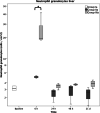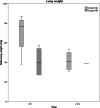In vivo immunomodulation of IL6 signaling in a murine multiple trauma model
- PMID: 36151360
- PMCID: PMC10060329
- DOI: 10.1007/s12026-022-09319-3
In vivo immunomodulation of IL6 signaling in a murine multiple trauma model
Abstract
A significant number of trauma patients die during the ICU phase of care because of a severe immune response. Interleukin-6 (IL6) plays a central role within that immune response, signaling through a membrane-bound (IL6-R) and a soluble IL6 receptor (sIL6-R). IL6 and the sIL6-R can form an agonistic IL6/sIL6-R-complex, activating numerous cells that are usually not IL6 responsive, a process called trans-signaling. We attempted to demonstrate that modulation of the IL6 signaling (classic signaling and trans-signaling) can attenuate the devastating immune response after trauma in a murine multiple trauma model. Mice were allocated to three study arms: sham, fracture or polytrauma. Half of the animals had the application of an IL6-R antibody following an intervention. After a pre-set time, blood samples were analysed for IL6 and sIL6-R serum levels, organs were analysed for neutrophil infiltration and end organ damage was evaluated. IL6 and sIL6-R showed a rapid peak after fracture, and much more markedly after polytrauma. These parameters were reduced significantly by globally blocking IL6 signaling via IL6-R antibody (Mab) application. Shock organ analysis also illustrated significant neutrophil infiltration following polytrauma, which was also abated via IL6-R Mab application. Furthermore, end organ damage was reduced by IL6-R Mab application. The study results prove the regulatory role of IL6 signaling pathways in polytrauma, with haemorrhagic shock being a major trigger of inflammatory response. Modulation of IL6 signaling shows promise in the prevention of adverse events like organ failure following major trauma and might be a target for in vivo immunomodulation to reduce mortality in severely injured patients, but further evaluation regarding classic IL6 signaling and IL6 trans-signaling is needed.
Keywords: IL6; Immunomodulation; Polytrauma; Trans-signaling; sIL6-R.
© 2022. The Author(s).
Conflict of interest statement
Kleber C. received a scientific grant from the B. Braun Stiftung. For the remaining authors, no conflicts were declared, and no further funding was provided.
Figures








References
-
- M. J. Oberholzer, Pathologie verstehen: molekulare Grundlagen der allgemeinen Pathologie. Thieme, 2001.
Publication types
MeSH terms
Substances
LinkOut - more resources
Full Text Sources
Research Materials

